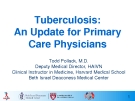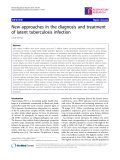Tuberculosis: An Update for Primary Care Physicians
Todd Pollack, M.D. Deputy Medical Director, HAIVN Clinical Instructor in Medicine, Harvard Medical School Beth Israel Deaconess Medical Center
1
Outline
Epidemiology of tuberculosis Diagnosis and treatment of latent
tuberculosis infection (LTBI)
Diagnosis of pulmonary tuberculosis,
including new diagnostics
Overview of tuberculosis treatment
2
Global Burden of TB, 2010
Estimated number of cases Estimated number of deaths
All forms of TB 8.8 million (range: 8.5–9.2 million) 1.1 million (range: 0.9–1.2 million)
HIV-associated TB
Global tuberculosis control: WHO report 2011.
1.1 million (13%) (Range: 1.0-1.2 million) 350,000 (range: 320,000-390,000)
3
TB cases, by region
Global tuberculosis control: WHO report 2011.
Majority of cases in 2010 occurred in Asia (59%) 4
Estimated TB Incidence Rates, 2010
Vietnam ranks 12 / 22 countries with the highest burden of TB
Global tuberculosis control: WHO report 2011.
5
TB Epidemiology in Vietnam, 2010
2010 Country Data Estimated new cases:
Multi-drug resistant TB: 2.7% of new TB
180,000
cases
Estimated TB deaths:
19% of re-treatment
29,000
cases
Case detection rate:
54% (43-71)
Global tuberculosis control: WHO report 2011
6
Latent TB Infection (LTBI)
In most individuals, TB infection is contained
initially by host defenses, and infection remains latent.
In Vietnam, an estimated 50-60% of the
population has latent TB infection*
Identification and treatment of LTBI can reduce the risk of development of disease by as much as 90 percent
*Source: Lien LT, et al. (2009) Prevalence and Risk Factors for Tuberculosis Infection among Hospital Workers in Hanoi, Viet Nam. PLoS ONE 4(8): e6798
7
Diagnosis of LTBI
Advantages
Tuberculin skin test (TST)
• Inexpensive • Historical “gold
standard”
• Requires a single
Disadvantages • Requires follow-up visit for reading • Reading is prone to subjective exam • False positives with recent BCG vaccine, non-TB mycobacteria
patient visit
Interferon gamma release assay (IGRA)*
• Limited data • Expensive • Errors in collecting and transporting blood can decrease accuracy
• Results available within 24 hours • BCG vaccination does not cause false positive
8 * WHO does not recommend the use of IGRAs in low and middle income countries.
Case Scenario
Duc is a 30 year-old man who is found to have latent TB infection (LTBI) during an employment health exam. He has no known contact with an active TB case. He is healthy with no medical problems. His employer also requires an HIV antibody test and his result is pending.
9
Question #1
What is his approximate risk for developing active TB if he is HIV negative? and what is his risk if he is HIV positive? a) Risk is same for both: 10% over lifetime b) HIV (-): 10% over lifetime; HIV (+): 10%
per year
c) HIV (-): 10% per year; HIV (+): 10% over
lifetime
10
Progression to TB Disease (1) TB and HIV People who are infected with both M. tuberculosis and HIV are much more likely to develop TB disease
TB infection and NO risk factors TB infection and HIV infection (pre-Highly Active Antiretroviral Treatment [HAART])
Risk is about 7% to 10% PER YEAR, a very high risk over a lifetime
Source: CDC Self-Study Modules on Tuberculosis, 2010
Risk is about 5% in the first 2 years after infection and about 10% over a lifetime
Progression to TB Disease (2)
Some conditions increase probability of LTBI progressing to TB disease
• Injection drug use • Underweight or malnourished
• HIV infection • Recent TB infection • History of prior, untreated TB or fibrotic lesions on chest x-ray
• Silicosis • Diabetes mellitus • Chronic renal failure or on
hemodialysis
• Solid organ transplantation • Prolonged therapy with corticosteroids or other immunosuppressants • Carcinoma of head or neck • Gastrectomy or jejunoilial
bypass
Source: CDC Self-Study Modules on Tuberculosis, 2010
12
Evaluation of Persons with Positive TST or IGRA
Person has a positive test for TB infection
TB disease ruled out
Consider for LTBI treatment
Person accepts and is able to receive treatment of LTBI
If person refuses or is unable to receive treatment for LTBI, follow-up TST or IGRA and serial chest radiographs are unnecessary
Develop a plan of treatment with patient to ensure adherence
Educate patient about the signs and symptoms of TB disease
Source: CDC Self-Study Modules on TB, 2010
13
Question #2
Assuming his HIV antibody test is negative, what is a preferred option for treatment of LTBI is this patient? a) Rifampin daily for 4 months Isoniazid daily for 9 months
b) c) Rifampin plus pyrazinamide daily for 2
d)
months Isoniazid plus rifapentine weekly for 3 months
14
Treatment Regimens for LTBI
Drug(s)
Duration
Interval
Minimum Doses
Isoniazid 9 months Daily 270
Twice weekly* 76
6 months Daily 180
Twice weekly* 52
3 months Once weekly* 12
Isoniazid & Rifapentine
* Use Directly Observed Therapy (DOT)
# Option equal to 9-month INH regimen in certain groups (healthy patients, ≥ 12 years old, at higher risk for developing TB)
Rifampin 4 months Daily 120
15 Source: Recommendations for Use of an Isoniazid-Rifapentine Regimen with Direct Observation to Treat Latent Mycobacterium tuberculosis Infection, MMWR, 2011
Case Scenario
After discussion with his physician, Duc elects not to take treatment for latent TB infection. One year later, he presents to the clinic with 2 weeks of fever, cough, and night sweats.
16
Question #3
What diagnostic tests should be ordered, if available, to evaluate for pulmonary TB? a) Chest x-ray and sputum smear for AFB b) Chest x-ray, sputum smear for AFB and
molecular testing (nucleic acid amplification) c) Chest x-ray, sputum smear for AFB, sputum
culture for AFB, and molecular testing
d) Chest x-ray, sputum smear for AFB, sputum culture for AFB, molecular testing, and drug susceptibility testing (if culture positive)
17
Diagnosis of Pulmonary TB
History and Exam
Chest Radiograph
Sputum AFB smear and culture
Nucleic Acid Amplification (NAA)
18
TB Chest Radiograph
Distinguishing features: 1) Predilection for upper lobes Apical and posterior
segments 2) Tendency for cavitation
Radiographic Manifestations of Tuberculosis: A Primer for Clinicians, 2nd Edition, June 2006
19
Diagnosis of Pulmonary TB Sputum AFB Smear and Culture
Sputum AFB smear
• Most rapid and inexpensive TB diagnostic tool • Obtain 3 sputum specimens • Sputum can be collected spontaneously or by
induction AFB Culture
• Higher sensitivity than microscopy
Smear: 45-80%; Culture: 80-98%
• Allows for drug susceptibility testing and species
identification
• Better for monitoring treatment response
20
Diagnosis of Pulmonary TB Nucleic Acid Amplification (NAA)
Amplification of a specific target RNA or DNA sequence
that can be detected via a nucleic acid probe
Provides rapid results (24-48 hours) High sensitivity and specificity in respiratory specimens
Sensitivity
Specificity
AFB Smear +
95%
98%
AFB Smear -
75-88%
95%
Does not replace need for AFB smear and culture
• Culture is required for drug susceptibility testing • NAA can detect nucleic acid from dead and live organisms so
not useful for monitoring treatment response
Source: Updated Guidelines for the Use of Nucleic Acid Amplification Tests in the Diagnosis of Tuberculosis, JAMA. 2009;301(10):1014-1016.
21
New TB Diagnostics: GeneXpert test (1)
Automated nucleic acid amplification test
Simultaneously
identifies M.TB and rifampin resistance Rapid results (< 2
hours)
17 machines
donated to Vietnam
Source: Rapid Molecular Detection of Tuberculosis and Rifampin Resistance, NEJM 2010; 363:1005
22
GeneXpert Test (2)
HIV (+) individuals suspected of having TB
Individuals at risk of MDR-TB
Primary considerations
• Diagnosed with TB • Suspected of having TB
HIV (-) individuals not at risk of MDR-TB with either:
Secondary considerations
• Abnormal CXR • Sputum smear (-) but still suspected of having TB
Individuals accessing health centre
Xpert MTB/RIF
TB, Rif resistance
TB, no Rif resistance
No TB detected
- MDR-TB regimen
- Appropriate further clinical management
- Drug susceptibility testing
- Treatment regimen based on patient history
Adapted from: Rapid implementation of the Xpert MTB/RIF diagnostic test, WHO 2011
Diagnosis of Pulmonary TB Interpretation of Test Results Action
Interpretation NAA
+ Diagnosis AFB smear +
-
+ Presumptive diagnosis
established
Start treatment Await culture results for drug susceptibility testing Repeat NAA to confirm result Consider starting TB therapy while awaiting culture results
- +
False negative NAA or Nontuberculous mycobacteria Repeat NAA to confirm result Use clinical judgment while awaiting culture results
- -
TB cannot be definitely excluded Use clinical judgment while 24 awaiting culture results
Case Scenario
Duc is diagnosed with pulmonary TB based on his clinical presentation and a positive sputum AFB smear. Culture and drug susceptibility testing is not available.
25
Question #4
What is the best treatment regimen for this patient? a) 2RHZE, 4RH b) 2RHZE, 6HE c) 2SRHZE, 1RHZE, 3HRE d) 2RHE, 6HE
NOTE: Rifampin (R), Isoniazid (H), Ethambutol (E), Pyrazinamide (Z), Streptomycin (S)
26
Basics of TB Treatment
Principles of treatment
• Use a safe, effective combination of drugs for
the shortest time possible
• Use multiple drugs • Never add single drug to failing regimen • Ensure adherence to therapy (DOT)
27
Basics of TB Treatment Initial Phase
TB must be treated with at least two drugs
to which the organism is susceptible. • Susceptibility is not known initially • Assume resistance until proven susceptible • Modify the regimen after results are known Begin with 4 drugs (in areas where the rate of INH monoresistance is > 4%)
28
Basics of TB Treatment Continuation Phase
Most patients are treated with a 4 month
continuation phase consisting of INH and RIF • RH leads to less treatment failure and relapse
compared to HE*
Total duration of treatment for pulmonary TB
is 6 months
Longer treatment is indicated for patients with bone and joint disease (6-9 nine months) and CNS disease (12 months)
*Source: Results at 30 months of a randomized trial of two 8-month regimens for the treatment of tuberculosis. IJTLD 15(6):741–745
29
Vietnam National TB Treatment Guidelines
Intensive Phase Indications
Continuation Phase
I S(H)ERZ x 2 months HE x 6 months
or RH* x 4 months
New TB cases *RH used only with DOT
HRE x 3 months Treatment failure,
recurrent or severe TB
II SRHZE x 2 months, then RHZE x 1 month
Source: Vietnam TB Treatment Guidelines. Ministry of Health, 2009.
III HRZE x 2 months HR x 4 months Pediatric TB cases
30
Key Points
Vietnam has one of the highest burden of TB
cases in the world
HIV infection significantly increases the risk
of progression from latent to active TB
NAA testing, when added to sputum smear and culture, allows for rapid diagnosis of pulmonary TB
Treatment should follow drug susceptibility testing, if available, and national treatment guidelines
31


















